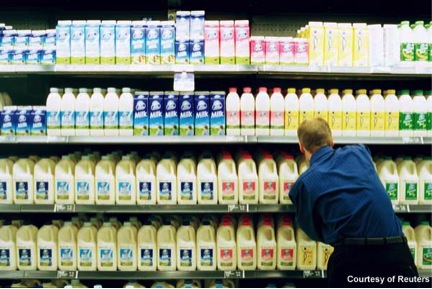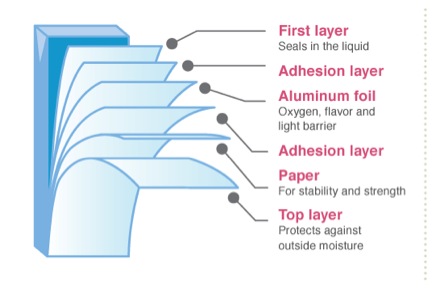
The options for milk–dairy and non-dairy–can seem dauntingly vast, especially when one considers shelf-stable varieties.
During a recent trip to my local grocery store, I encountered a new price-comparison conundrum around a household staple: milk. All my life milk has been a given in my refrigerator–first dairy, then Skim Plus, then a rotating stock of soy or almond milk. My fridge looked barren without it, and the fear of milk-less tea or coffee was palpable.
My mother likes to say that she has no clue how much milk costs because she’ll buy it no matter what; if it’s on sale, great, but if not she won’t leave it unchecked on her grocery list. For her daughter, a self-proclaimed girl on a budget, though, the decision to buy milk requires calculation, coupon clipping, strategic shopping trips to certain stores, or any combination thereof. Usually, a quart will last me, in my singleton lifestyle, 3-4 weeks, which means I can plan for the expense pretty well.
You may be scratching your head at this point thinking, Why is she so obsessed with milk? It’s just a few dollars! But with the price of everything going up–I’ve watched the price tag on Silk go from $3.49 to $4.19 to $4.49 over the last 2 years–every penny counts. To buy or not to buy is the question as I stand in front of the refrigerator case, contemplating whether my need and desire for the carton outweigh those of the fresh beets/apples/berries in my cart.
Last week, though, I stumbled upon a groundbreaking, albeit somewhat obvious, solution to my woes: shelf-stable milk. There was an entire tower of rectangular cartons of the same exact product I had taken from the case around the corner for literally half the price. I’d be stupid not to choose that option, but I paused. There was something indescribably icky about the idea of milk being out of the refrigerator, even if only in its unopened state. It made me curious about why and how this breed of milk existed, and whether the money I saved buying it would cost me in healthfulness.
Dumplings, I have good news: there’s no difference in the nutritional value or ingredients of shelf-stable milk from refrigerated milk. What makes it able to stay on the shelf prior to opening is the container, called a Tetra Pak. Founded in 1951 during the age of convenience and domestic technologies, the company revolutionized the food industry by giving a longer life span to previously perishable items. Comprised of five layers, Tetra Pak cartons block out oxygen, light, and moisture to protect the liquid inside prior to refrigeration. The combination of thin paperboard, polyethelyne plastic, and aluminum foil make for a lightweight, strong, and recyclable package.
Shelf-stable dairy milk requires an additional Ultra High Temperature (UHT) treatment for “ultra-pasteurization” (vs. standard pasteurization), but that’s not the case for non-dairy milk; likewise for other liquids, like broth or juice, that come in cardboard containers.
For more proof: simply compare the ingredients list in the two kinds of Silk Unsweetened Original Almond milk (my brand of choice–it’s carrageenan-free!):
Refrigerated: Almond milk (Filtered Water, Almonds), Sea Salt, Locust Bean Gum, Sunflower Lecithin, Gellan Gum, Natural Flavor.
Shelf-Stable: Almond milk (Filtered Water, Almonds), Sea Salt, Locust Bean Gum, Sunflower Lecithin, Gellan Gum, Natural Flavor.
See? Identical.
The only thing to remember is to refrigerate your carton before opening (purely so that it’s cold when you use it); the recommended use-by date is 7-10 days after opening, but I’ve never had a problem keeping it (much) longer.
I’m looking forward to my next shelf-stable non-dairy milk purchase, which will ensure I get the same quality nutrition but without the (meager) financial stress. Will you make the switch?
Also see: How to Make DIY Almond Milk
By Jennifer: 5 Things I Learned from Gwyneth Paltrow (and 2 I didn’t)
Raw Vegan Crunchy Apple Sweet Potato Salad
Inspired Living: 3 Ways to Be Rich in Life
__
Photos: my-own-test-kitchen.blogspot.com/Reuters; milkunleashed.com





